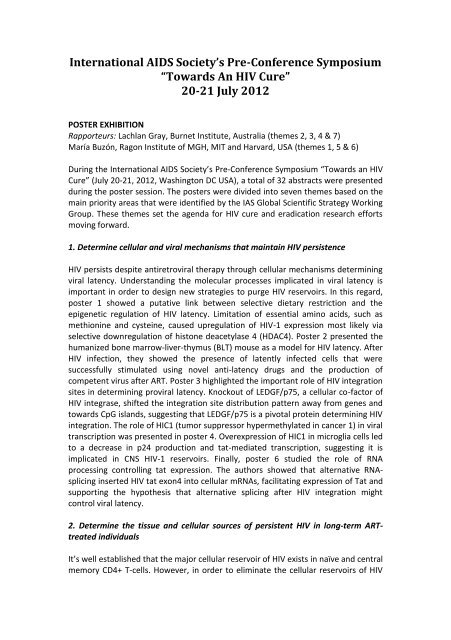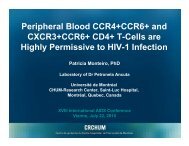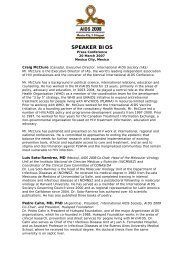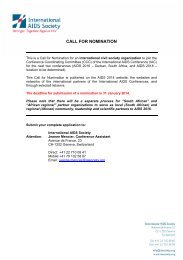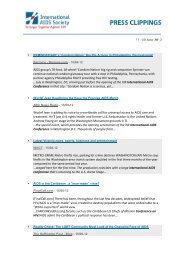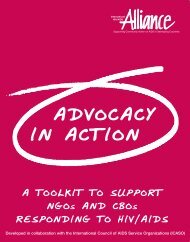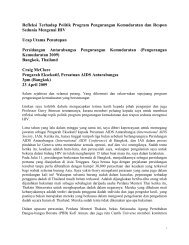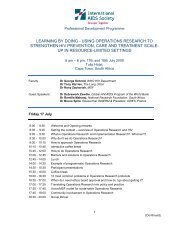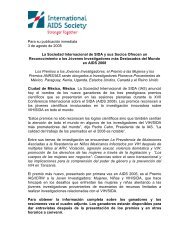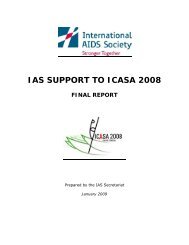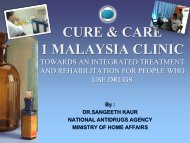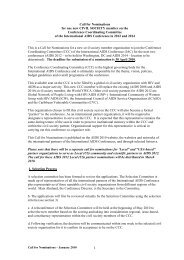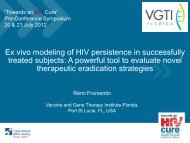Poster Exhibition - International AIDS Society
Poster Exhibition - International AIDS Society
Poster Exhibition - International AIDS Society
Create successful ePaper yourself
Turn your PDF publications into a flip-book with our unique Google optimized e-Paper software.
<strong>International</strong> <strong>AIDS</strong> <strong>Society</strong>’s Pre-Conference Symposium<br />
“Towards An HIV Cure”<br />
20-21 July 2012<br />
POSTER EXHIBITION<br />
Rapporteurs: Lachlan Gray, Burnet Institute, Australia (themes 2, 3, 4 & 7)<br />
María Buzón, Ragon Institute of MGH, MIT and Harvard, USA (themes 1, 5 & 6)<br />
During the <strong>International</strong> <strong>AIDS</strong> <strong>Society</strong>’s Pre-Conference Symposium “Towards an HIV<br />
Cure” (July 20-21, 2012, Washington DC USA), a total of 32 abstracts were presented<br />
during the poster session. The posters were divided into seven themes based on the<br />
main priority areas that were identified by the IAS Global Scientific Strategy Working<br />
Group. These themes set the agenda for HIV cure and eradication research efforts<br />
moving forward.<br />
1. Determine cellular and viral mechanisms that maintain HIV persistence<br />
HIV persists despite antiretroviral therapy through cellular mechanisms determining<br />
viral latency. Understanding the molecular processes implicated in viral latency is<br />
important in order to design new strategies to purge HIV reservoirs. In this regard,<br />
poster 1 showed a putative link between selective dietary restriction and the<br />
epigenetic regulation of HIV latency. Limitation of essential amino acids, such as<br />
methionine and cysteine, caused upregulation of HIV-1 expression most likely via<br />
selective downregulation of histone deacetylase 4 (HDAC4). <strong>Poster</strong> 2 presented the<br />
humanized bone marrow-liver-thymus (BLT) mouse as a model for HIV latency. After<br />
HIV infection, they showed the presence of latently infected cells that were<br />
successfully stimulated using novel anti-latency drugs and the production of<br />
competent virus after ART. <strong>Poster</strong> 3 highlighted the important role of HIV integration<br />
sites in determining proviral latency. Knockout of LEDGF/p75, a cellular co-factor of<br />
HIV integrase, shifted the integration site distribution pattern away from genes and<br />
towards CpG islands, suggesting that LEDGF/p75 is a pivotal protein determining HIV<br />
integration. The role of HIC1 (tumor suppressor hypermethylated in cancer 1) in viral<br />
transcription was presented in poster 4. Overexpression of HIC1 in microglia cells led<br />
to a decrease in p24 production and tat-mediated transcription, suggesting it is<br />
implicated in CNS HIV-1 reservoirs. Finally, poster 6 studied the role of RNA<br />
processing controlling tat expression. The authors showed that alternative RNAsplicing<br />
inserted HIV tat exon4 into cellular mRNAs, facilitating expression of Tat and<br />
supporting the hypothesis that alternative splicing after HIV integration might<br />
control viral latency.<br />
2. Determine the tissue and cellular sources of persistent HIV in long-term ARTtreated<br />
individuals<br />
It’s well established that the major cellular reservoir of HIV exists in naïve and central<br />
memory CD4+ T-cells. However, in order to eliminate the cellular reservoirs of HIV
we need to comprehensively characterize all cell types that may contribute to it, as<br />
each cell type may have unique mechanisms of latency and persistence.<br />
In poster 7, Zink et al., identify macrophages as another potential cell type that may<br />
be contributing to the HIV reservoir within the CNS. In poster 8, Ruel et al., studied<br />
pediatric cART cases in Uganda and identified that the HIV reservoir is most<br />
pronounced in naïve CD4+ T-cells and is predominantly established by CXCR4-tropic<br />
virus. This work highlights important considerations for strategies aimed at virus<br />
eradication because of the differences that may exist between viral reservoirs in<br />
adults and children. Finally, in poster 9, Donahue et al., proposed superinfection of<br />
latently infected cells as a potential mechanism for the emergence of multi-drug<br />
resistant virus.<br />
3. Determine the origins of immune activation and inflammation in the presence of<br />
ART and their consequences for HIV persistence<br />
It’s well known that chronic immune activation and inflammation caused by HIV<br />
plays a central role in premature ageing, bone disease, heart disease and several<br />
other debilitating conditions. However, their role in the establishment and<br />
maintenance of viral reservoirs is less well understood. In posters 10-14, the authors<br />
identify several new immune mediators that may play a key role in HIV persistence.<br />
In poster 11, Naicker et al., propose polymorphisms in IL-10 as a potential mediator<br />
of altered cytokine production that may act as a driver of chronic HIV infection and<br />
HIV persistence. In poster 13, Reece et al., studied an SIV model confirming that viral<br />
reservoirs are established early and highlighting the need for early interventions to<br />
restrict their expansion. Additionally, they suggested that eliminating cells while<br />
under high turnover would achieve the greatest impact in reducing viral reservoirs.<br />
4. Determine host and immune mechanisms that control infection but allow viral<br />
persistence<br />
Numerous studies have investigated the correlates of protection and viral control<br />
against HIV, highlighting strong CTL responses and broad neutralizing antibodies.<br />
However, their relationship to viral persistence remains to be determined. In posters<br />
15-16, the authors attempt to dissect this relationship and in the process uncover<br />
some interesting findings. In poster 16, Conceicao et al., undertook genome wide<br />
expression studies of patients pre- and post-cART and compared these against a<br />
panel of long-term non-progressors (LTNP). Their findings suggest that LTNP have a<br />
block in apoptosis pathways which in turn favors strong immune responses that<br />
assists in controlling viremia.<br />
5. Study, compare and validate assays to measure persistent infection<br />
<strong>Poster</strong> 17 studied viral replication in human M1-MDM (monocyte-derived<br />
macrophage). They showed a transient but robust restriction of HIV replication in<br />
those cells compared to M2-MDM. In <strong>Poster</strong> 18 the role of Vacc-4x, a p24 peptidebased<br />
HIV therapeutic vaccine, was evaluated in 135 patients. The authors showed
that the vaccinated group experienced a significant reduction in viral load compared<br />
to placebo. <strong>Poster</strong> 19 assessed the size and decay of the resting CD4+ T cell reservoir<br />
over the first two years of life in 17 infected infants initiating early therapy. The size<br />
of the reservoir was associated with the time to first undetectable viral load.<br />
6. Develop and test therapeutic agents or immunological strategies to safely<br />
eliminate latent infection in individuals on ART<br />
Developing novel therapeutic interventions that might potentially clear latent<br />
infection is important for achieving sterilizing or functional cure. In this regard,<br />
poster 20 presented the potential of tre-recombinase to reverse in vivo HIV-1<br />
infection using a humanized mouse model. Tre-recombinase was efficiently delivery<br />
into cells using a lentiviral vector, and excised HIV-proviral DNA from chromosomal<br />
integration sites. <strong>Poster</strong> 21 presented delivery systems for targeting specifically CD4<br />
T cells. They showed activation of latent infection using liposomes containing<br />
bryostatin, and they introduce a new nanoparticle called “Vault” with enhanced<br />
means to deliver therapeutic agents with minimal cell activation. <strong>Poster</strong> 22<br />
presented an interesting observation regarding the lack of re-emergence of CXCR4<br />
variants in the “Berlin Patient” after stem cell transplantation. Those CXCR4 variants<br />
depended on CCR5 co-receptor for viral replication in functional assays. The<br />
potential of Rapamycin, an immunosuppressant, was evaluated in poster 24 after<br />
kidney transplantation. The authors observed a trend to towards higher plasma HIV<br />
RNA and lower HIV DNA over time after the transplant. In poster 25, the efficacy of<br />
multidrug ART and anti reservoir drugs (mega ART) in a range of viremic conditions<br />
in macaques was evaluated. Complete reduction of viral load was achieved, with a<br />
reduction of the viral set point after therapy interruption. In addition, they observed<br />
a spontaneous control of low level viremia strictly dependent on CD8+ T cells. <strong>Poster</strong><br />
26 showed that CD4-AsiCs (CD4 aptamer-siRNA chimera), intravaginally applied in<br />
solution or in a gel formulation in a BLT mouse, knocked down CCR5 expression<br />
reducing viral load and delaying CD4 decline after HIV infection.<br />
7. Develop and test strategies to enhance the capacity of the host response to<br />
control active viral replication (Lachlan)<br />
Targeting viral reservoirs will not be sufficient on it’s own to eradicate HIV. In<br />
addition to eliminating latently infected cells, the patient’s immune system will also<br />
need to be enhanced so that it can effectively clear any residual viral replication. In<br />
posters 27-32, the authors suggest new ways of boosting and reinvigorating the<br />
immune system to effectively target HIV replication. In poster 27, Vanham et al.,<br />
propose dendritic cells as a potential mediator to enhance potent immune<br />
responses. In poster 28, Pavlakis et al., describe a DNA vaccine encoding p55gag that<br />
maximizes anti-Gag responses. In poster 29, Yi et al., describe the induction of<br />
broadly neutralizing antibodies against the HIV-1 Env membrane proximal region. All<br />
of these strategies of boosting immune response show promise and could play a role<br />
in future efforts to enhance anti-HIV immunity.


